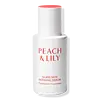What's inside
What's inside
 Key Ingredients
Key Ingredients

 Benefits
Benefits

 Concerns
Concerns

 Ingredients Side-by-side
Ingredients Side-by-side

Water
Skin ConditioningPropanediol
SolventButylene Glycol
HumectantNiacinamide
Smoothing1,2-Hexanediol
Skin ConditioningPrunus Persica Fruit Extract
AbrasiveDioscorea Japonica Root Extract
Skin ConditioningSodium Hyaluronate
HumectantAdenosine
Skin ConditioningHydrolyzed Sodium Hyaluronate
Skin ConditioningMadecassoside
AntioxidantHydrolyzed Hyaluronic Acid
HumectantSodium Acetylated Hyaluronate
HumectantAcetyl Octapeptide-3
HumectantEthylhexylglycerin
Skin ConditioningHydrolyzed Corn Starch
HumectantSodium Carbomer
Emulsion StabilisingBeta-Glucan
Skin ConditioningSaccharide Isomerate
HumectantPhytic Acid
Sucrose
HumectantAsiaticoside
AntioxidantCaprylyl Glycol
EmollientWater, Propanediol, Butylene Glycol, Niacinamide, 1,2-Hexanediol, Prunus Persica Fruit Extract, Dioscorea Japonica Root Extract, Sodium Hyaluronate, Adenosine, Hydrolyzed Sodium Hyaluronate, Madecassoside, Hydrolyzed Hyaluronic Acid, Sodium Acetylated Hyaluronate, Acetyl Octapeptide-3, Ethylhexylglycerin, Hydrolyzed Corn Starch, Sodium Carbomer, Beta-Glucan, Saccharide Isomerate, Phytic Acid, Sucrose, Asiaticoside, Caprylyl Glycol
Water
Skin ConditioningButylene Glycol
HumectantCastanea Crenata Shell Extract
Skin ConditioningPEG-60 Hydrogenated Castor Oil
EmulsifyingCinnamomum Cassia Bark
Skin ConditioningAnthemis Nobilis Flower Extract
MaskingRhus Semialata Gall Extract
Skin ConditioningCaprylyl Glycol
EmollientCarbomer
Emulsion StabilisingTriethanolamine
BufferingSalix Alba Bark Extract
Astringent1,2-Hexanediol
Skin ConditioningAllantoin
Skin ConditioningAmmonium Acryloyldimethyltaurate/Vp Copolymer
Camellia Sinensis Leaf Extract
AntimicrobialYeast Ferment Extract
Skin ConditioningEthylhexylglycerin
Skin ConditioningDipotassium Glycyrrhizate
HumectantMentha Haplocalix Extract
MaskingHamamelis Virginiana Leaf Extract
Skin ConditioningMenthyl Lactate
MaskingGlycerin
HumectantHydrolyzed Albumen
Skin ConditioningScutellaria Baicalensis Root Extract
AstringentBeta-Glucan
Skin ConditioningGlycine
BufferingGlutamic Acid
HumectantHistidine
HumectantLysine
Skin ConditioningProline
Skin ConditioningSerine
MaskingAlanine
MaskingArginine
MaskingAspartic Acid
MaskingLeucine
Skin ConditioningThreonine
Valine
MaskingParfum
MaskingPhenoxyethanol
PreservativeLimonene
PerfumingLinalool
PerfumingHexyl Cinnamal
PerfumingCitronellol
PerfumingWater, Butylene Glycol, Castanea Crenata Shell Extract, PEG-60 Hydrogenated Castor Oil, Cinnamomum Cassia Bark, Anthemis Nobilis Flower Extract, Rhus Semialata Gall Extract, Caprylyl Glycol, Carbomer, Triethanolamine, Salix Alba Bark Extract, 1,2-Hexanediol, Allantoin, Ammonium Acryloyldimethyltaurate/Vp Copolymer, Camellia Sinensis Leaf Extract, Yeast Ferment Extract, Ethylhexylglycerin, Dipotassium Glycyrrhizate, Mentha Haplocalix Extract, Hamamelis Virginiana Leaf Extract, Menthyl Lactate, Glycerin, Hydrolyzed Albumen, Scutellaria Baicalensis Root Extract, Beta-Glucan, Glycine, Glutamic Acid, Histidine, Lysine, Proline, Serine, Alanine, Arginine, Aspartic Acid, Leucine, Threonine, Valine, Parfum, Phenoxyethanol, Limonene, Linalool, Hexyl Cinnamal, Citronellol
 Reviews
Reviews

Ingredients Explained
These ingredients are found in both products.
Ingredients higher up in an ingredient list are typically present in a larger amount.
1,2-Hexanediol is a synthetic liquid and another multi-functional powerhouse.
It is a:
- Humectant, drawing moisture into the skin
- Emollient, helping to soften skin
- Solvent, dispersing and stabilizing formulas
- Preservative booster, enhancing the antimicrobial activity of other preservatives
Beta-Glucan is a polysaccharide. It can be derived from the cell walls of seaweed, oats, yeast, and fungi. It hydrates the skin and helps boost your skin's natural barrier.
As an antioxidant, beta-glucan helps fight free-radicals. Free-radicals are molecules that may damage your skin cells, such as pollution.
Studies show this ingredient may be an effective wrinkle reducer as it can deeply penetrate into skin. It has also been show to help with wound healing.
Learn more about Beta-GlucanButylene Glycol (or BG) is used within cosmetic products for a few different reasons:
Overall, Butylene Glycol is a safe and well-rounded ingredient that works well with other ingredients.
Though this ingredient works well with most skin types, some people with sensitive skin may experience a reaction such as allergic rashes, closed comedones, or itchiness.
Learn more about Butylene GlycolCaprylyl Glycol is a humectant and emollient, meaning it attracts and preserves moisture.
It is a common ingredient in many products, especially those designed to hydrate skin. The primary benefits are retaining moisture, skin softening, and promoting a healthy skin barrier.
Though Caprylyl Glycol is an alcohol derived from fatty acids, it is not the kind that can dry out skin.
This ingredient is also used as a preservative to extend the life of products. It has slight antimicrobial properties.
Learn more about Caprylyl GlycolEthylhexylglycerin (we can't pronounce this either) is commonly used as a preservative and skin softener. It is derived from glyceryl.
You might see Ethylhexylglycerin often paired with other preservatives such as phenoxyethanol. Ethylhexylglycerin has been found to increase the effectiveness of these other preservatives.
Water. It's the most common cosmetic ingredient of all. You'll usually see it at the top of ingredient lists, meaning that it makes up the largest part of the product.
So why is it so popular? Water most often acts as a solvent - this means that it helps dissolve other ingredients into the formulation.
You'll also recognize water as that liquid we all need to stay alive. If you see this, drink a glass of water. Stay hydrated!
Learn more about Water